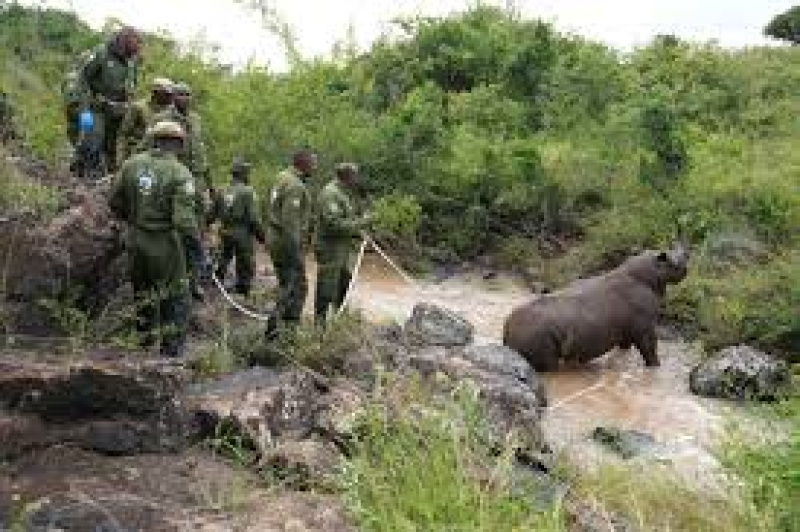- Hadi's condition 'very critical' after bullet causes 'massive brain injury' |
- DMP intensifies drive to arrest attackers of Hadi |
- Tarique terms attack on Hadi a conspiracy against democracy |
- Man held for tying, beating up youth on theft suspicion in Gazipur |
- Sajid (2) lifted after 32 hrs from deep Rajshahi well, not alive |
Endangered Rhinos Return to Plateau in Central Kenya

Conservationists in Kenya are celebrating as rhinos were returned to a grassy plateau that hasn't seen them in decades.
The successful move of 21 eastern black rhinos to a new home will give them space to breed and could help increase the population of the critically endangered animals. It was Kenya's biggest rhino relocation ever.
The rhinos were taken from three parks that are becoming overcrowded to the private Loisaba Conservancy, where herds were wiped out by poaching decades ago, reports VOA.
"It's been decades since rhinos roamed here, almost 50 years ago," said Loisaba security manager Daniel Ole Yiankere. "Their numbers were severely impacted by poaching. Now, our focus is on rejuvenating this landscape and allowing rhinos to breed, aiming to restore their population to its former splendor."
Moving rhinos safely is a serious challenge. The 18-day exercise involved tracking the rhinos using a helicopter and then shooting them with tranquilizer darts. Then the animals — which weigh about a ton each — have to be loaded into the back of a truck for the move.
Disaster nearly struck early in the relocation effort, when a tranquilized rhino stumbled into a creek. Veterinarians and rangers held the rhino's head above water with a rope to stop it from drowning while a tranquilizer reversal drug took effect, and the rhino was released.
Some of the rhinos were transferred from Nairobi National Park and made a 300-kilometer trip. Others came from two parks closer to Loisaba.
Rhinos are generally solitary animals and are at their happiest in large territories. As numbers in the three parks where the rhinos were moved from have increased, wildlife officials decided to relocate some in the hope that they will be happier and more likely to breed.
David Ndere, an expert on rhinos at the Kenya Wildlife Service, said their reproduction rates decrease when there are too many in a territory.
"By removing some animals, we expect that the rhino population in those areas will rise up," Ndere said. "And then we reintroduce that founder population of at least 20 animals into new areas."
Loisaba Conservancy said it has dedicated around 25,000 hectares to the new arrivals, which are a mix of males and females.
Kenya has had relative success in reviving its black rhino population, which dipped from around 20,000 in the 1970s to below 300 in the mid-1980s because of poaching, according to conservationists, raising fears that the animals might be wiped out completely in the country. Kenya now has around 1,000 black rhinos, the third biggest population behind South Africa and Namibia.
There are just over 6,400 wild black rhinos left in the world, all of them in Africa, according to the Save the Rhino organization.
Tom Silvester, the CEO of Loisaba Conservancy, said Kenya's plan is to get its black rhino numbers to 2,000 over the next decade.
"Once we have 2,000 individuals, we will have established a population that will give us hope that we have brought them back from extinction," he said.
Kenyan authorities say they have relocated more than 150 rhinos in the last decade.
An attempt to move 11 rhinos in 2018 ended in disaster when all of the animals died shortly after moving.
Ten of the rhinos died from stress, dehydration and starvation intensified by salt poisoning as they struggled to adjust to saltier water in their new home, investigations found. The other one was attacked by a lion.
Since then, new guidelines have been created for the capture and moving of rhinos in Kenya. Silvester said tests have been conducted on the water quality at Loisaba.
Kenya is also home to the last two remaining northern white rhinos on the planet. Researchers said last month they hope they might be able to save that subspecies after creating an embryo in a lab from an egg and sperm previously collected from white rhinos and transferring it into a surrogate female black rhino. The pregnancy was discovered in a postmortem after the surrogate died of an infection following a flood.

